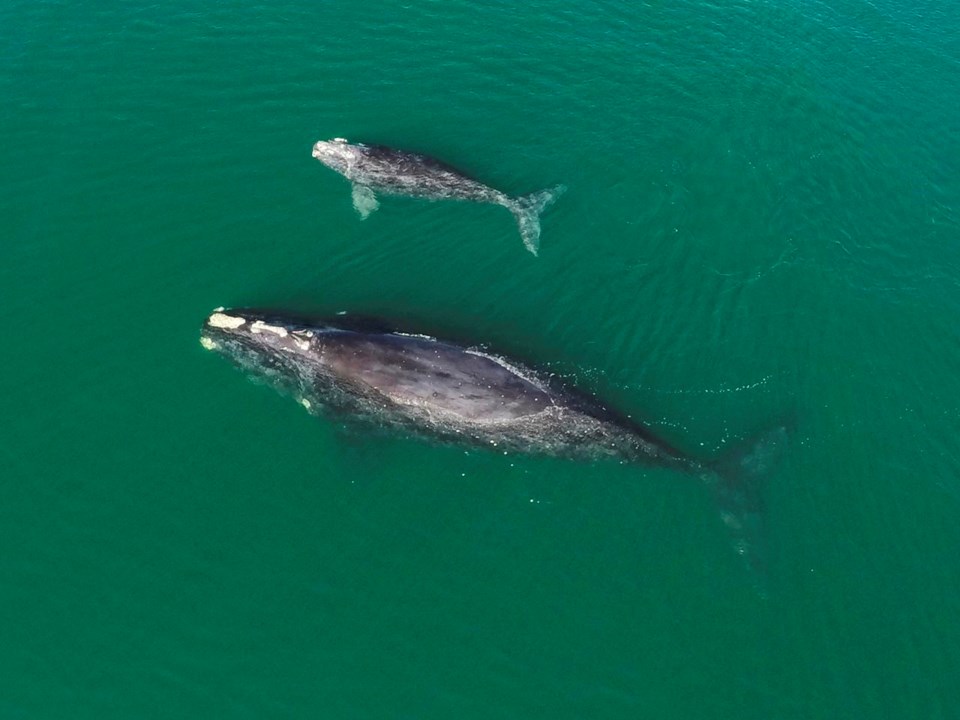FREDERICTON — An international environmental organization is calling on the federal government to step up protections for endangered North Atlantic right whales beyond the 2023 measures it's opting to repeat this year, noting birth rates are already below expectations for the season and at least three of the 19 calves born so far are believed to have died.
Oceana Canada campaign director Kim Elmslie said observers should have logged between 25 and 30 new calf births so far, since the total local whale population of 360 contains about 70 reproducing females.
"It's positive because we're having a few more calves," she said Friday in a telephone interview, adding only 12 new right whales were born last year. "So that's a positive, but the deaths of calves is really distressing because that's the future of the species."
The birthing season for right whales starts toward the end of November and goes on until February, she said.
Right whales generally give birth off the coast of Georgia and Florida in the south and make their way back up to Canada for feeding, she said.
"I've heard them be called the urban whale because they do travel somewhat close to shore along the Eastern U.S. ... and up into Canadian waters," Elmslie said.
"But along the way they're encountering all of these different vessels that are transiting the area. And millions of lines worth of fishing gear between the U.S. and Canada. There's the lesser problems of ocean noise and pollution runoff. It's very challenging for these animals. They have threats throughout their entire range."
The U.S.-based National Oceanic and Atmospheric Administration Fisheries, which tracks right whales, documents calf births on its website dating back as far as 2007. Data show births began rebounding after hitting a low of zero in 2018. They rose to seven the following year, 10 in 2020 and 20 in 2021 before dipping back to 15 in 2022 and 12 last year.
Right whales, it said, become sexually mature at around 10 and give birth to one calf after a yearlong pregnancy.
While the gap between births is usually three years, now right whales are having calves every six to 10 years, it said.
"Biologists believe the additional stress from entanglements, vessel strike injuries, and changes in prey availability due to climate change all likely contribute to right whales calving less often, even when the females survive the event," the website said.
While a "relatively" productive year for right whales would see at least 20 births, it said rates of human-caused mortality and serious injury mean there need to be at least 50 or more calves per year for "many years" to stop the decline of the species.
Elmslie highlighted a study published earlier this month in the journal Biological Sciences, where researchers found entanglements in fishing gear are a main factor in the diminishing number of right whales.
Between 1990 and 2017, the study said those factors accounted for the deaths of at least 41 animals. It said authorities found 21 whales killed by vessel collisions and another 20 that died due to gear entanglements.
Instances of moderate to severe entanglements have surged in the past decade, the study reads.
"Entanglement in fishing gear is one of the key threats facing North Atlantic right whales," it concluded. "Almost all females, 89 per cent, have experienced at least one entanglement event during their lifetime, and almost two-thirds of these have experienced two or more, with many resulting in injury or mortality."
"Consistent with previous work, we found that female North Atlantic right whales who experience a severe entanglement have reduced survival probability."
Fisheries and Oceans Canada announced earlier this week it was making no changes to last year's right whale protection measures, noting the same speed restrictions, gear prohibitions and area closures triggered by signs of a whale will remain unchanged in 2024.
Elmslie said she's glad Ottawa left the same measures in place because North Atlantic right whales need all the help they can get, but added there's need for more action including making ropeless fishing gear a priority.
She said establishing lending libraries for such equipment could help with an eventual transition, adding fish harvesters could borrow the ropeless gear for the season without having to shell out for unfamiliar tools.
The higher the demand for ropeless gear, she said, the more the price would drop.
"We do have, through technology, a solution, the ropeless gear solution to remove the rope from the water, and that's going to help not just right whales, but all of those baleen whales that are in the Gulf of St. Lawrence," she said. "So hopefully some positives will come out of this."
This report by The Canadian Press was first published March 29, 2024.
Hina Alam, The Canadian Press

